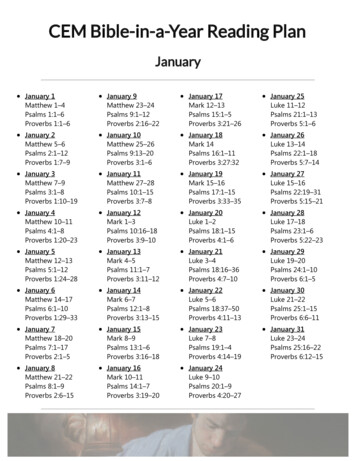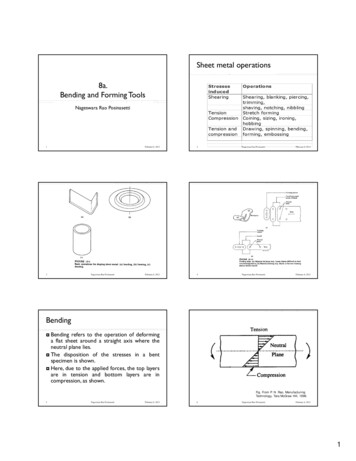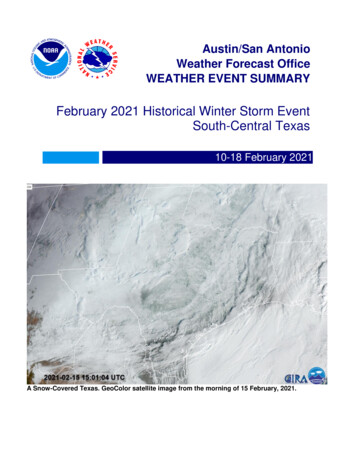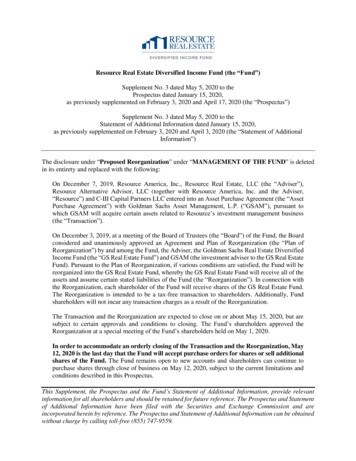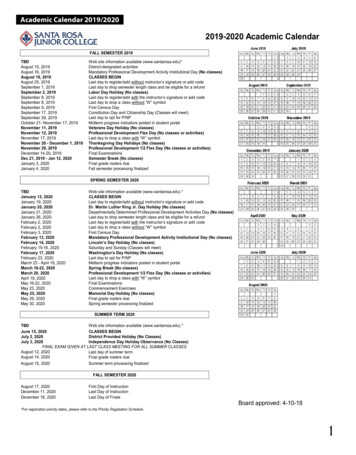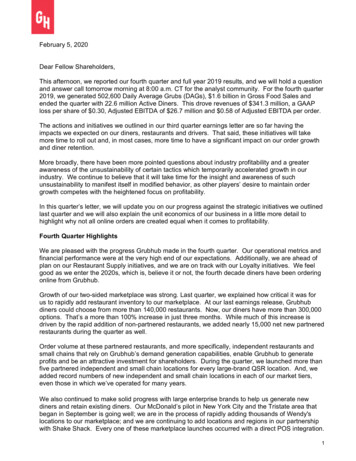
Transcription
February 5, 2020Dear Fellow Shareholders,This afternoon, we reported our fourth quarter and full year 2019 results, and we will hold a questionand answer call tomorrow morning at 8:00 a.m. CT for the analyst community. For the fourth quarter2019, we generated 502,600 Daily Average Grubs (DAGs), 1.6 billion in Gross Food Sales andended the quarter with 22.6 million Active Diners. This drove revenues of 341.3 million, a GAAPloss per share of 0.30, Adjusted EBITDA of 26.7 million and 0.58 of Adjusted EBITDA per order.The actions and initiatives we outlined in our third quarter earnings letter are so far having theimpacts we expected on our diners, restaurants and drivers. That said, these initiatives will takemore time to roll out and, in most cases, more time to have a significant impact on our order growthand diner retention.More broadly, there have been more pointed questions about industry profitability and a greaterawareness of the unsustainability of certain tactics which temporarily accelerated growth in ourindustry. We continue to believe that it will take time for the insight and awareness of suchunsustainability to manifest itself in modified behavior, as other players’ desire to maintain ordergrowth competes with the heightened focus on profitability.In this quarter’s letter, we will update you on our progress against the strategic initiatives we outlinedlast quarter and we will also explain the unit economics of our business in a little more detail tohighlight why not all online orders are created equal when it comes to profitability.Fourth Quarter HighlightsWe are pleased with the progress Grubhub made in the fourth quarter. Our operational metrics andfinancial performance were at the very high end of our expectations. Additionally, we are ahead ofplan on our Restaurant Supply initiatives, and we are on track with our Loyalty initiatives. We feelgood as we enter the 2020s, which is, believe it or not, the fourth decade diners have been orderingonline from Grubhub.Growth of our two-sided marketplace was strong. Last quarter, we explained how critical it was forus to rapidly add restaurant inventory to our marketplace. At our last earnings release, Grubhubdiners could choose from more than 140,000 restaurants. Now, our diners have more than 300,000options. That’s a more than 100% increase in just three months. While much of this increase isdriven by the rapid addition of non-partnered restaurants, we added nearly 15,000 net new partneredrestaurants during the quarter as well.Order volume at these partnered restaurants, and more specifically, independent restaurants andsmall chains that rely on Grubhub’s demand generation capabilities, enable Grubhub to generateprofits and be an attractive investment for shareholders. During the quarter, we launched more thanfive partnered independent and small chain locations for every large-brand QSR location. And, weadded record numbers of new independent and small chain locations in each of our market tiers,even those in which we’ve operated for many years.We also continued to make solid progress with large enterprise brands to help us generate newdiners and retain existing diners. Our McDonald’s pilot in New York City and the Tristate area thatbegan in September is going well; we are in the process of rapidly adding thousands of Wendy'slocations to our marketplace; and we are continuing to add locations and regions in our partnershipwith Shake Shack. Every one of these marketplace launches occurred with a direct POS integration.1
We are also really excited about the launch of KFC-branded online ordering. Diners can now visitorder.kfc.com, powered by Grubhub, and get the Colonel’s secret recipe for pickup or delivery.Launching their direct branded ordering experience has meaningfully increased daily KFC onlineordering, and they “own” every one of those diners because we are sharing data. KFC, like TacoBell and our other close partners, can focus on building their online brands in a sustainable fashioninstead of just paying bounties for transactions from anonymous diners.It was also a good quarter for diner growth. We added more net active diners to the platform thanany prior quarter, with the exception of the first quarter of 2019 (which included the Taco Bell launch,a substantial Taco Bell-funded TV campaign and elevated levels of advertising spend). Even with areturn to more typical levels of growth in advertising spend this quarter, we still added 1.4 millionactive diners.Our advertising cost per new diner in the fourth quarter was relatively unchanged from the first threequarters of the year. And while the new diners are not quite as valuable as they have been in thepast – for the reasons we outlined last quarter – we remain confident that the lifetime value of thesenewly acquired diners remains higher than their acquisition cost. We also believe that over time wewill be able to increase the value of these diners, and frankly of all our diners, by executing on ourrestaurant inventory and economically sustainable loyalty initiatives. In the meantime, ourmarketplace continues to grow in the right ways, which positions us well for the future.Weather impacts our business in good ways and bad. Typically, the tailwinds (e.g., precipitation)balance out the headwinds (e.g., unseasonable warmth in winter) over the course of a quarter;however, in the fourth quarter, we believe we had a little net help. Even without the help from theweather, which we believe accounted for approximately 150 bps of DAG growth, our businessperformed well, with 8% year-over-year reported DAG growth, 19% growth in Net Revenues and 27million in Adjusted EBITDA – which includes meaningful investments in the strategic initiatives weoutlined last quarter.Diner Behavior UpdateLast quarter, we talked about the changed behavior of our diners. All of our diners, to some extent,were ordering less frequently on our platform than we expected based on their historical behavior,but this trend was most pronounced among our newer diners and those in our newer markets. In thefourth quarter, our diner ordering behavior was at the higher end of our expectations based on thetrends we saw late in the third quarter. As expected, growth decelerated after accounting forweather, but the amount of the deceleration was less than we expected.When thinking about our newest diners, it’s important to remember a few things. For one, wecontinue to add new diners disproportionately in newer markets – resulting in a mix shift away fromNew York and Corporate, which both have very high activity rates. Also, as discussed last quarter,we are leaning in more to some channels, like free delivery and food offers, that have historicallyyielded lower quality diners. And, as we’ve documented, new diners are increasingly alreadycustomers of other platforms. All of these factors result in our newest diners having lower orderingfrequencies than our historical new diners.2
Strategic Initiatives Update – Improving CompetitivenessWe are pleased with our progress on both our Restaurant Supply and Diner Loyalty initiatives thatwe highlighted last quarter. We are either on track or ahead of our plans for both and steadilyimproving our competitive position. It’s important to reiterate that these initiatives are not magicbullets that will improve diner behavior immediately. They will have some small short-term benefit,but are designed more to drive long-term behavior, while allowing us to continue to generate profits.Restaurant Supply Independent Partnered Restaurants We had the largest number of independent restaurants additions ever in the fourthquarter. This strength was broad across all of our markets. We signed more independent restaurants per sales rep than any point in the last severalyears. We are ahead of plan to double the size of our independent restaurant sales force, withmuch of the hiring likely to take place before the second half of 2020.Enterprise Partnered Restaurants We added thousands of new, partnered locations of beloved national brands includingApplebee’s, Dunkin’, McDonald’s, Popeyes, Shake Shack and Wendy’s. We also made substantial progress with regional chains, adding stores and meaningfulorder volume for popular partners including: Bertucci’s, Hale & Hearty, honeygrow, LaMadeleine, Mimi’s Café, Round Table Pizza and Smokey Bones.Non-partnered Restaurants We launched approximately 150,000 non-partnered restaurants on the platform and arewell ahead of our goal of doubling total restaurant inventory by the end of 2020. The non-partnered restaurant mix is comprised of both enterprise and independentrestaurants, with the mix similar to our partnered inventory. Orders from non-partnered restaurants accounted for a low-single digit percentage ofour total orders. As expected, high diner fees resulted in lower conversion. Non-partnered restaurants received orders from both new and existing diners. These arediners and orders we may have lost to a competitor platform if we didn't have the nonpartnered inventory. We are pricing non-partnered orders so that we break even on an incremental EBITDAbasis, including opportunity costs from substitutive orders.3
Diner Loyalty Restaurant Funded Programs Since the third quarter, we launched more than 20 loyalty programs for Enterprisepartners on our marketplace, where diners can “earn and burn” rewards on our platform.Early feedback on these programs has been positive from the brands, with higher orderfrequency and higher average order sizes. We just recently started offering these same loyalty programs to independentrestaurants on our platform. We believe this unique offering will create differentiatedvalue for independent restaurants that partner with Grubhub.Pricing Optimization We have been piloting a diner subscription program in a few markets that leverages ourlowest consumer-facing pricing, diverse restaurant selection and innovative products likeloyalty. We are fine tuning the program ahead of a national rollout, likely in the comingmonths, with the goal to increase diner frequency and loyalty in a long-term, sustainablemanner. We continue to make great strides optimizing our pricing across the network to enhancediner lifetime value. There are almost infinite combinations of variables for pricing todiners, and we see potential for continued optimization over many years.Ultimate LaunchIn late January, we launched Grubhub Ultimate, a revolutionary, proprietary hardware and softwaresolution that integrates all restaurant ordering channels into one system. Ultimate is a digitalworkflow solution, connecting the front- and back-of-the house directly with diners and creating atransparent view into their order status, whether diners order for pickup or delivery on Grubhub, atan in-store kiosk, or directly with a cashier (Grubhub Ultimate Video Overview).Grubhub UltimateWe believe that pickup could be the next major supply-side innovation to unlock accelerated growthin our industry. While transparent order wait-time functionality has been available in some largescale QSR brands, we brought this functionality to our independent restaurant partners, includingreal-time queue display (in-person and online), as well as in-store ordering kiosks.In the past, we’ve highlighted that Tapingo and LevelUp were fulfilling hundreds of thousands ofpickup orders every day and that we were hoping to bring some of that pickup “DNA” and technologyto the Grubhub marketplace. Ultimate is a concept that was born at Tapingo and is an importantstep in helping Grubhub unlock pickup, which is a majority of the more than 250 billion takeoutmarket and virtually untapped by online/mobile platforms.4
Unit Economics – Why All Online Orders Are NOT EqualIn our last letter, we underscored the importance of building the foundation of our business as amarketplace for independent restaurants and small chains. For those constituents, our model ispowerful – we provide demand generation at a value that works for both parties. Large enterpriseand non-partnered volume supplements the marketplace by attracting and retaining diners, but thoseorders alone are not the path to profitability.We thought some examples of delivery orders would help further illustrate this point. Below arethree real orders on Grubhub, although we have intentionally redacted the restaurant names andlocations. Here are the checkout screens the diner sees for each order and below are illustrativeGrubhub economics for each of these orders: The first example (“Independent”) is a partnered independent restaurant that values our demandgeneration capabilities and utilizes our delivery services; we have a higher take-rate and collectthe diner delivery fee. The second example (“QSR”) is a partnered national enterprise brand. The order size issignificantly smaller and the restaurant is a large brand so it pays us less for demandgeneration, but utilizes our delivery services. Revenue from the restaurant is significantly lowerbecause the commission rate is lower AND the order size is smaller. The last example (“Non-Partnered”) is a non-partnered independent restaurant where the foodand beverage total is similar to the Independent example. Remember, we have no relationshipwith the restaurant, so our revenue from the restaurant is 0. We receive all of our revenuefrom the diner through a combination of the delivery fee and a service fee.Our “Variable order costs” for each of these orders consists of delivery, customer care and creditcard processing. Because we believe ancillary driver costs like insurance, recruiting, backgroundchecks and delivery bags scale with volume, we allocated them to “Delivery costs” along with whatwe pay the driver. Similarly, we allocated customer care costs, including customer contact costsplus any refunds or concessions we give to diners, to “Variable order costs.”5
Despite the significant drop in Grubhub revenue between the Independent and QSR orders, thevariable costs are actually very similar. This makes intuitive sense. As we talked about in our lastletter, we have to pay someone for their time to drive to the restaurant, pick up the food and drive itto the diner. These costs really don’t change based on the cost of the meal or whether therestaurant is an Independent or a QSR. In fact, the QSR variable order costs are actually higherbecause the lower average order sizes often requires companies like Grubhub to provide a subsidyto encourage a driver to accept the order.The variable costs for a Non-Partnered order are actually quite a bit higher than either anIndependent or a QSR order. We need to pay someone, either the driver or a call centerrepresentative, to place the order and potentially wait for it to be prepared. We also have highercustomer care costs because there tends to be more problems with these orders, and we bear 100%of the responsibility for restaurant errors.You can see how we can generate approximately 4 an order to pay for overhead in theIndependent example, but something much closer to 0 in the QSR example. This is BEFOREmarketing, technology, sales, account management, rent and other corporate overhead, which for ustotaled approximately 2.50 per order in 2019. We realize it’s easy to forget these overhead costswhen evaluating growth businesses, but they are real, critical operating costs.As we’ve highlighted many times, we are strong believers in the value of having a robust QSRoffering as part of the marketplace, but only as an enhancement, not the core driver of growth andprofitability. The chart below illustrates how QSR mix impacts overall profitability using our actualoverhead costs, which we believe are already the lowest in the industry:Profit per Order versus QSR Order Mix 5.00Dollars per Order 4.00 3.00 2.00 1.00 0.00( 1.00)( %Percent Order Mix from QSRBlended contribution profit per orderAssumptionsIndependent restaurant contribution profit per orderQSR contribution profit per order1Overhead per order1Overhead per orderEBITDA per order 4.00 0.00 2.50Overhead per order excludes depreciation and amortization, stock-based compensation, acquisition, restructuring and legal costs. Grubhub's overhead perorder was 2.51 for the full year 2019.6
We would be losing money overall if QSR volume and/or Non-Partnered volume made upeven a third of our business. It’s true that corporate overhead costs will scale to somedegree with volume, but we think it will require multiples of current order volume to get below 2 per order. Therefore, we believe a heavy QSR and/or Non-Partnered mix would result inlosses at 500,000 DAGs, 1 million DAGs or even more.Bottom line is that volume from partnered independent restaurants is critical to overallprofitability. An independent restaurateur is a different customer than an Enterprise partner,with different needs. We believe Grubhub has the best infrastructure to serve independentrestaurants and the most diners that want to habitually order from them.GuidanceLast quarter, we outlined how the initiatives we are undertaking to increase restaurantselection and expand diner loyalty would affect our profitability and DAG growth rate in 2020.To date, we have made substantial progress on the initiatives, but as we’ve said, theseinitiatives are long-term focused, not short-term fixes. They will take time to ramp and affectdiner behavior. We believe the best measure of success will be an improving DAG growthrate as the initiatives take hold.With this backdrop, we expect full year 2020 revenue to be in the range of 1.4 billion to 1.5billion. We continue to anticipate that in 2020, the year-over-year DAG growth rate willimprove from the weather adjusted 6% year-over-year growth in the fourth quarter of 2019.Given the time needed for the initiatives to scale and affect diner behavior, we believe ordergrowth will ramp throughout 2020, with the first quarter being the low point.We continue to expect adjusted EBITDA for full year 2020 to be at least 100 million. We arenot giving a range for full year EBITDA given the large amount of potential variability inpatterning and spend related to our initiatives. Much of the spend is discretionary and willdepend on diner behavior, competitive behavior and other factors. All of that said, we remainvery confident in our ability to generate at least 100 million in EBITDA for the full year.For the first quarter, we expect revenue to be in the range of 350 million to 370 million. ForDAG growth, we are obviously not assuming the kind of weather tailwind we saw in the fourthquarter, and as we’ve said, we do not expect our initiatives to have a material impact on firstquarter order growth yet. Also recall we are lapping the national launch of Taco Bell whichincluded a substantial television advertising campaign that contributed an estimated 150 bpsto first quarter 2019 DAG growth.We expect first quarter adjusted EBITDA to be in the range of 15 million to 25 million.Business UpdatesRestaurant NetworkWe now have more than 300,000 restaurants on our platform, including more than 155,000that work with Grubhub on a partnered basis.Fourth Quarter Key Business Metrics2 and Financial Review 2 KeyNew Diners and Daily Average Grubs: We finished the quarter with 22.6 million activediners, up 28% year-over-year and up 1.4 million sequentially. DAGs were 502,600 inthe fourth quarter, up 8% year-over-year and up 10% from the third quarter. Favorableweather benefited our year-over-year DAG growth by about 150 bps.Business Metrics are defined on page 29 of our Annual Report on Form 10-K filed on February 28, 2019.7
Gross Food Sales: Gross Food Sales for the fourth quarter were 1.6 billion, anincrease of 13% from the fourth quarter of 2018, with our average order size up 5%year-over-year to 34. Net Revenues: Net Revenues for the fourth quarter were 341 million, an increase of19% year-over-year. Even without the approximately 150 bps weather benefit, ourrevenue would have been near the high end of our fourth quarter guidance. Our capturerate, calculated as Net Revenues divided by Gross Food Sales, was 22% and includesroughly 100 bps from LevelUp and Tapingo’s technology-oriented revenues. Excludingthese technology-oriented revenues, our capture rate increased by approximately 100bps year-over-year. The majority of the take-rate increase is due to the mix shift towardsdelivering a greater percentage of orders on behalf of our restaurant partners, partiallyoffset by some of our initiatives, which are accounted for as a reduction in revenue.Finally, we continue to see a small upward impact on take-rate from restaurants optingto pay more for more impressions on our marketplace. Operations and Support: Operations and support expenses were 190 million, anincrease of 32% year-over-year, driven by the disproportionate increase in Grubhubdelivered orders relative to the underlying growth of our overall order volume. Orders wedeliver on behalf of our restaurant partners accounted for approximately 40% of ourDAGs during the quarter. Revenue less operations and support costs per order, whichhelps normalize for the mix shift to more Grubhub-delivered orders, was 3.26 per order,a decline from 3.82 in the third quarter, and in-line with our expectations outlined in thethird quarter shareholder letter. The sequential decline in contribution profit per orderwas largely due to our initiatives, as the fulfillment cost per delivered order wasunchanged from the third quarter. Sales and Marketing: Sales and marketing expenses were 86 million in the fourthquarter, a year-over-year increase of 23%. Despite the lower ordering frequency of ournewly acquired diners, we continue to acquire new diners whose expected LTV is abovetheir cost of acquisition. We anticipate sales and marketing will grow at a morenormalized rate in 2020, as we have fully lapped the stepped up level of advertisingspend which began in the fourth quarter of 2018. As a note, advertising spend, which isthe majority of sales and marketing expense, but not all, grew less than 20% comparedto the fourth quarter of 2018. Technology: Technology expenses were 29 million, an increase of 17% year-overyear and down 1% on a sequential basis. Technology expense growth slowed from 39%in the third quarter as we fully lapped the acquisition of LevelUp. General and Administrative: General and Administrative expenses were 28 million,an increase of 2% year-over-year. After adjusting for non-recurring acquisition,restructuring and legal costs, general and administrative expenses were about 27million, a sequential increase of 3 million. Depreciation and Amortization: Depreciation and amortization expenses were 32million, an increase of 35% year-over-year. Net Loss: Net loss was 27.7 million, compared to 5.2 million in the fourth quarter of2018.8
Adjusted EBITDA: Fourth quarter 2019 Adjusted EBITDA was 26.7 million or 0.58per order. Adjusted EBITDA benefited from the 150 bps weather tailwind to ordergrowth. The sequential decline in adjusted EBITDA per order was due to: (1) our newestcohorts ordering less frequently than prior cohorts, (2) co-marketing and free delivery forcertain enterprise partners including KFC, McDonald’s, Panera Bread and Taco Bell,and (3) investments in our new initiatives.ClosingWe continue to feel good about the course we charted for our business in the last earningsletter, but we acknowledge that we have a lot of work still to do. We are encouraged by whatwe’ve seen in our business over the last few months; however, these strategic initiatives willtake time to roll out and have a meaningful impact on our diner behavior and our overallbusiness.We will host a question and answer call for the investor community at 8:00 a.m. CT tomorrowmorning. A live webcast of the call can be accessed on the Grubhub Investor Relationswebsite at investors.grubhub.com, along with the Company's earnings press release,financial tables, and Shareholder Letter. A replay of the webcast will be available at thesame website.Thank you for your continued support and we look forward to updating you on our progress.Sincerely,Matt Maloney, Founder and CEOAdam DeWitt, President and CFO9
Forward Looking StatementsThis Shareholder Letter contains “forward-looking statements,” regarding management'sfuture expectations, beliefs, intentions, goals, strategies and protocols, which are made inreliance on the “safe harbor” provisions of the U.S. Private Securities Litigation Act of 1995.Forward-looking statements involve substantial risks, known and unknown, uncertainties,assumptions, and other factors that may cause actual results, performance, achievements oroutcomes including, but not limited to, achievement of the benefits of our planned additionalinvestments, to differ materially from future results expressed or implied by such forwardlooking statements. Forward-looking statements generally relate to future events or our futurefinancial or operating performance. In some cases, you can identify forward-lookingstatements because they contain words such as “anticipates,” “believes,” “contemplates,”“could,” “seeks,” “estimates,” “intends,” “may,” “plans,” “potential,” “predicts,” “projects,”“should,” “will,” “would” or similar expressions and the negatives of those terms. Whileforward-looking statements are our best prediction at the time they are made, you should notrely upon them. Forward-looking statements represent our management’s beliefs andassumptions only as of February 5, 2020, unless otherwise indicated, and there is noimplication that the information contained in this Shareholder Letter is made subsequent tosuch date. For additional information concerning factors that could affect our financial resultsor cause actual results to differ materially from those expressed or implied in the forwardlooking statements, please refer to the cautionary statements included in our filings with theSecurities and Exchange Commission (the “SEC”), including the “Risk Factors” section of ourAnnual Report on Form 10-K filed with the SEC on February 28, 2019 and our QuarterlyReports on Form 10-Q and any further disclosures we make in our Current Reports on Form8-K. Our SEC filings are available electronically on our investor website atinvestors.grubhub.com or the SEC’s website at www.sec.gov. Except as required by law, weassume no obligation to update these forward-looking statements or this Shareholder Letter,or to update, supplement or correct the information set forth in the Shareholder Letter or thereasons actual results could differ materially from those anticipated in the forward-lookingstatements, even if new information becomes available in the future.10
Use of Non-GAAP Financial MeasuresAdjusted EBITDA, non-GAAP net income and non-GAAP net income per diluted shareattributable to common stockholders are financial measures that are not calculated inaccordance with accounting principles generally accepted in the United States, or GAAP.We define Adjusted EBITDA as net income adjusted to exclude acquisition, restructuring andcertain legal costs, income taxes, net interest expense, depreciation and amortization andstock-based compensation expense. Non-GAAP net income and non-GAAP net income perdiluted share attributable to common stockholders exclude acquisition, restructuring andcertain legal costs, amortization of acquired intangible assets, stock-based compensationexpense and other nonrecurring items as well as the income tax effects of these non-GAAPadjustments. We use these non-GAAP financial measures as key performance measuresbecause we believe they facilitate operating performance comparisons from period to periodby excluding potential differences primarily caused by variations in capital structures, taxpositions, the impact of acquisitions, restructuring and certain legal costs, the impact ofdepreciation and amortization expense on our fixed assets and the impact of stock-basedcompensation expense. Adjusted EBITDA, non-GAAP net income and non-GAAP netincome per diluted share attributable to common stockholders are not measurements of ourfinancial performance under GAAP and should not be considered as an alternative toperformance measures derived in accordance with GAAP.Contacts:Adam PatnaudeInvestor Relationsir@grubhub.comKatie NorrisMedia Relationspress@grubhub.com11
GRUBHUB INC.STATEMENTS OF OPERATIONS(in thousands, except per share data)Three Months EndedDecember 31,20192018 341,270 287,721RevenuesCosts and expenses:Operations and supportSales and marketingTechnology (exclusive of amortization)General and administrativeDepreciation and amortizationTotal costs and expensesIncome (loss) from operationsInterest expense - netIncome (loss) before provision for income taxesIncome tax (benefit) expenseNet income (loss) attributable to commonstockholders Net income (loss) per share attributable to commonstockholders:Basic Diluted Weighted-average shares used to compute netincome (loss) per share attributable to 28,01832,488366,098(24,828 )6,189(31,017 )(3,299 )Year EndedDecember 31,20192018 1,312,151 756 )2,163(4,919 ,283 )20,493(26,776 )(8,210 081,4332,952(27,718 ) (5,150 ) (18,566 ) 78,481(0.30 ) (0.30 ) (0.06 ) (0.06 ) (0.20 ) (0.20 ) 92,354KEY BUSINESS METRICSActive Diners (000s)Daily Average GrubsGross Food Sales (millions)Three Months EndedDecember 31,2019201822,62117,688502,600467,500 1,552 1,377Year EndedDecember 31,2019201822,62117,688492,300435,900 5,914 5,05712
GRUBHUB INC.CONSOLIDATED BALANCE SHEETS(in thousands, except share data)December 31,2018December 31,2019ASSETSCURRE
Ultimate Launch In late January, we launched Grubhub Ultimate, a revolutionary, proprietary hardware and software solution that integrates all restaurant ordering channels into one system. Ultimate is a digital workflow solution, connecting the front- and back-of-the house directly with diners and creating a

